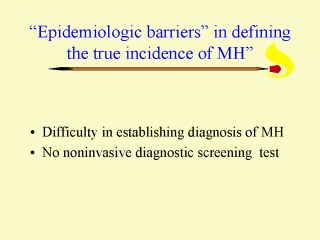| front |1 |2 |3 |4 |5 |6 |7 |8 |9 |10 |11 |12 |13 |14 |15 |16 |17 |18 |19 |20 |21 |22 |23 |24 |25 |26 |27 |28 |29 |review |
 |
The
epidemiology of Malignant Hyperthermia (MH) is very difficult to study. Although MH
susceptibility is transmitted as an autosomal dominant trait, it has variable expression.
Drug exposure and other environmental factors can influence the development of an episode
of clinical MH. The following are the major “epidemiologic barriers” in defining the
true incidence of MH: (1) Difficulty in establishing clinical diagnosis of MH - MH may present in several ways. Even in the so-called classic MH, the initial clinical manifestation is very non-specific. Hypercarbia, tachycardia, and fever, for example, can also be found in other medical conditions like thyrotoxicosis, sepsis, neuroleptic malignant syndrome, and other diseases causing ventilation problems. (2) Diagnostic testing suitable for routine screening is not available - IVCT is an invasive and cumbersome procedure. It is done by obtaining a muscle tissue from the patient usually under general anesthesia. It involves transport of this tissue to one of the few laboratories that follows accepted procedures for this diagnostic test (see www.mhaus.org). Testing is done within 4 hours to ensure viability of the muscle tissue. There are 2 available protocols for IVCT. These are the European Malignant Hyperthermia Group (EMHG) protocol and the North American Malignant Hyperthermia Group (NAMHG) protocol (1-5). Both protocols are subject to false positives. Molecular genetic diagnostic testing is another possible way of establishing the diagnosis of MH. However, its use at this time is limited to families in which contracture tests and clinical events have been linked to a causative gene for MH (6). Some studies suggest that MH susceptibility could be linked to the RYR1 gene in >50% of individuals examined (7) in some populations, while within a family of known MH susceptibility (8) diagnostic tests can perform much better. However, if an individual from a MH susceptible family does not have the causative gene found in other family members only IVCT can prove that individual is not MH susceptible. |
| front |1 |2 |3 |4 |5 |6 |7 |8 |9 |10 |11 |12 |13 |14 |15 |16 |17 |18 |19 |20 |21 |22 |23 |24 |25 |26 |27 |28 |29 |review |